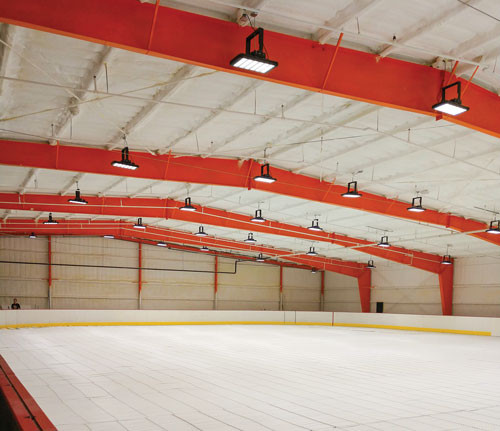Skating Away


Spray Foam Magazine – Fall Issue 2019 – As residents of one of America’s hottest states, Floridians are, more often than not, enthralled by activities that stray from the heat and keep the temperature down. For them, it’s almost natural to keep a mental or physical list of places to go for leisure activities in case the weather outside is too hot for even a day at the beach. In those circumstances, a trip down to the ice skating rink is a viable option on a year-round basis. But ice rinks are not easy finds and they are not located in every corner of the Sunshine State, so folks may sometimes need to take a drive to find them—or hope one “pops up” nearby all of a sudden.
In the heart of Lakeland, Florida, a highly anticipated ice arena is on the verge of being unveiled (Editor’s Note: This article is being written at the end of August and the Lakeland Ice Arena as of now has not announced an opening date). Formerly a bowling alley, the arena is being repurposed and remodeled to be a one-of-a-kind destination in this Central Florida town for all things involving ice skates. It is Polk County’s first year-round skating rink, bringing amateur skaters of all ages, as well as aspiring figure skaters and NHL players, together. The Lakeland Ice Arena is also the home of the town’s very own hockey teams—the Lakeland Royals and the George Jenkins High School Ice Hockey Team. Now, the Lakeland community is getting a new place to cool off while gliding on the ice, whether it be for public skating with the family or for a couple’s night out.
Keeping It Cool
When you break it down, the common denominator of the Lakeland Ice Arena—or any ice skating arena for that matter—is the “big freeze.” That is providing the necessary temperature for the ice sheet that the skaters glide on. When creating a new ice surface, indoor temperatures are extremely important. Being that the ambient temperature of an ice arena should be at approximately 52° F and humidity at 30 percent, one degree off from warm conditions outside can make a big difference in the quality of the ice. For this reason, high-quality insulation is of the utmost importance in order to keep the dehumidified conditioned air inside the building. That was one of the biggest considerations during the initial remodeling stage of the 50,000 square-foot venue, which aside from its grandiose ice sheet also includes a pro shop, a bar, viewing areas, a game room, an indoor ball-hockey room, two conference/party rooms, individual workstations with wi-fi access, and several dining spaces. In addition, forecasting the energy costs that would be incurred to cool down the arena could have made owner Paul Granville’s head spin, but luckily there was a solution for both issues. Granville found that solution when he elected to have the entire arena insulated with spray polyurethane foam (SPF).
An astute move on Granville’s part; here’s why: Spraying closed-cell SPF to the building envelope of the arena sealed every nook and cranny, which helps regulate the temperature inside, and minimizes the strain on the HVAC system of having to work hard to keep the building cool while the conditioned air inside the building is maintained. The alternative, fiberglass batts, could not have accomplished this and provided a likelihood of cost inefficiency and repeated replacement being highly likely and, in that same token, costly. In order to accomplish this application, Granville brought in Spray Pro Insulation, LLC (Spray Pro), a spray foam insulation contracting company based in Lakeland. Although the Spray Pro team had completed many spray foam installations to metal buildings and cold storage facilities, this was their first ice rink. Spray Pro welcomed the challenge and the experience with a full understanding that SPF was the best possible material for this type of structure. Spray Pro’s Jason Fortson notes that although spray foam does provide multiple benefits to the building, energy efficiency was the principal reason for the application.
“The ambient temperature of an ice rink is approximately 52 degrees and it’s important to insulate it as well as possible to keep the dehumidified conditioned air inside the building envelope, prevent condensation, and lower utility bills compared to traditional methods,” says Fortson. “The purpose of installing spray foam was to provide a superior insulation method for the Lakeland Ice Arena resulting in lower utility bills compared to fiberglass.”
Putting in the Work
Fortson, his colleague and sprayer, Josh Heckler, as well as two other crew members of the Spray Pro team tackled the insulation project, which consisted of the application of closed-cell spray polyurethane foam to the metal substrate of the exterior walls and the curved ceiling of the arena. Of course, this took place when the frame of the building had been constructed and none of the other rooms in the blueprint had been built out.
The insulation team was tasked to complete the job in three short weeks to stay ahead of the other trades that need to work in the arena. They brought two rigs on-site, which they parked outside the entrance to the arena to work with ease. The Spray Pro crew first prepped the area by masking the floors, windows, doors, and I-beams in the arena with plastic sheeting and tape. The crew situated large industrial exhaust fans for ventilation of the spray areas and suited up in spray suits, full-face fresh air respirators, protection gloves, and boots prior to the application. Then, they fired up their PMC PH-40 high-output proportioner attached to 300 feet of hose and, at the other end, handled a Graco Fusion AP spray gun. Because the ceiling was approximately 25 feet off the ground, the crew operated a scissor lift to spray the underside of the roof beyond the building’s steel I-beams as well as the higher areas of the exterior walls.
The Spray Pro crew installed to the exterior walls and the underside of the roof three inches of GacoOnePass, a 2 lb. closed-cell spray polyurethane foam made by Gaco Western. GacoOnePass is a UL GREENGUARD and GREENGUARD Gold certified foam that installs quickly in up to four-plus-inch passes, which reduces labor costs by 50 percent or more and offers 20-30 percent higher yields than standard 2 lb. foams when sprayed in one pass at three to four-inch thickness. The installation encompassed 23,600 square feet of roof deck and 10,700 square feet of wall space.
Although GacoOnePass is Appendix X-approved for use without an additional ignition barrier and meets the requirement for a Class II vapor retarder at just 0.44 inches, the Spray Pro crew still specified a thermal barrier coating to fire protect the metal building. Using a Graco Mark IV airless sprayer, the crew coated the spray foam with 16 mils of white Fireshell F10E, an NFPA 286, and non-toxic, water-based thermal barrier intumescent coating that provides oxygen starvation to fire.
Witnessing Results

Closed-cell spray foam was applied to the metal substrate of the exterior walls and the curved ceiling of the arena.
Photos provided by Spray Pro Insulation, LLCThe Spray Pro crew completed the job before the three-week deadline. With the foam in place, Fortson points out that the ambient temperature in the rink area was decreased and it actually felt cooler around the area.
“There’s no conditioned air escaping and unless they are having the doors opened for a prolonged period of time. The consistency of temperature inside the arena will be attributed to the spray foam in the walls and ceiling,” says Fortson. “The spray foam system will definitely pay for itself in energy costs in a few years.”
Granville was extremely satisfied with Spray Pro’s work and has lined up future work for Fortson and his team. He mentioned that the spray foam is performing better than he could have imagined.
“The spray foam has done such a great job at insulating the building that the ice has cured exceptionally hard, which makes a phenomenal playing surface,” affirms Granville. “I had to turn the ‘chiller’ setting up a little because it was actually getting colder than they expected!”
The application did not only yield fantastic performance for the Lakeland Ice Arena, but it also brought Spray Pro recognition for their prowess at insulating ice rinks—they recently secured a job for another ice rink project starting at the end of the year with similar size and scope as this one. This speaks volumes of the quality of work performed in Spray Pro’s first ice rink project—not to mention the efficiency and effectiveness of spray polyurethane foam as the no-brainer insulating material to install in these types of structures.
“Yes, we have another ice rink project coming up; I guess we didn’t do too badly with this one and word got out!” says Fortson. “We’ll be able to add this to our area of expertise in terms of buildings we’ve worked on. We also have a bowling alley and an indoor basketball court project coming up; it seems like building owners of arenas are becoming more and more familiar with the benefits of spray foam.”
Disqus website name not provided.






































